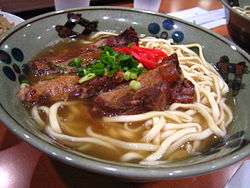Okinawa soba
 Sōki soba | |
| Alternative names | Soba, suba |
|---|---|
| Type | Japanese noodles |
| Place of origin | Japan |
| Region or state | Okinawa Prefecture |
| Main ingredients | Noodles (wheat flour), broth (konbu, katsuobushi flakes, pork) |
Okinawa soba (沖縄そば) is a type of noodle soup produced in Okinawa Prefecture, Japan. Okinawa soba is a regional collective trademark of The Okinawa Noodle Manufacturing Co-op.[1] In Okinawa, it is sometimes simply called soba, or suba in many Okinawan dialects, although this word typically refers to buckwheat noodles. The thick wheat noodles resemble udon, while the soup is more similar to that of ramen.
The noodles tend to have a circular cross section in the Yaeyama Islands, and tend to be slightly flat in the rest of Okinawa Prefecture. It is served in a broth flavored with konbu (edible seaweed), katsuobushi flakes and pork.
Standard toppings are kamaboko (fish cake), sliced scallion and a thick slice of stewed san-mai niku (三枚肉, pork belly; lit. "three-layer meat") or soki (boneless pork ribs), and usually garnished with beni shōga (pickled ginger).
For extra spice, diners can add a few drops of kōrēgūsu, which consists of chile peppers soaked in awamori rice liquor.
Varieties include:
- Sōki soba (ソーキそば) - topped with extra ribs, known as sōki in Okinawan.
- Tebichi soba (てびちそば) - topped with stewed Pig's trotters.
Name
Today the word soba means buckwheat, in particular buckwheat noodles, in Japanese. This word is in origin an abbreviation of soba-mugi (buckwheat). The word soba refers to the edge in ancient Japanese, and soba-mugi meant "edgy wheat". Around the 16th century, buckwheat began to be processed into thin noodles. This method was originally known as soba-kiri (lit. soba cutting) but it was later abbreviated into soba. Note that soba was mainly consumed in eastern Japan. It was not popular in western Japan including Okinawa. Buckwheat noodles remain rare in Okinawa, where they are known as Nihon soba (Japanese soba) or kuroi soba (black soba).
In modern Japan, the meaning of soba was extended so that it could refer to other types of thin noodles. Yakisoba (stir-fried noodles) contain no buckwheat. Shina soba, commonly known as Chūka soba or rāmen today, is also made from wheat flour. Okinawa soba falls into this category and is made entirely from wheat.
Under a fair competition regulation, soba was standardized as "the noodles contain at least 30% of buckwheat." This definition caused a problem when Okinawa was returned to Japan in 1972. In 1976, the Fair Trade Commission tried to make Okinawa Prefecture drop the name "soba" because Okinawa's soba did not conform to the regulation. The Okinawa Noodle Manufacturing Co-op negotiated with the Fair Trade Commission and, as a result, it was accepted as one of several exceptions, under the name of Okinawa soba.
History
Some attempt to trace the origin of Okinawa soba back to the Ryūkyū Kingdom period. It is pointed out that Chinese delegates possibly brought wheat noodles to the royal court.[2] However, they fail to establish a link to the modern Okinawan cuisine.[3]
The first known documented reference to Okinawa soba is of 1902 or the late Meiji period. At that time, it was known as Shina soba (Chinese soba) as in mainland Japan. Several soba restaurants are known to have run in Naha in the Taishō period. They used to have close links with the red-light district.[3] Soba restaurants were destroyed by U.S. attacks during the Battle of Okinawa. Its revival began in U.S. internment camps where wheat rations were supplied. In the 1960s soba was popularized with the introduction of noodle making machines. The popularization was accompanied by the transformation from a restaurant meal to home cooking. The mainland Japanese custom of eating soba on New Year's Eve was introduced to Okinawa in 1968 but buckwheat noodles were replaced by wheat noodles. Today Okinawa soba is considered as a vital part of traditional Okinawan culture although folklorist Nishimura Hidemi argued that it was an invented tradition.[3] Currently, the soba has been adopted as a local tradition in Campo Grande, state of Mato Grosso do Sul, Brazil, due to the large Okinawan-descendent population in the 850,000 inhabitants city. It’s usual to find specialized restaurants along the city, serving a local adaptation of the dish, due to the originally difficulty of finding sea fish in that western region of Brazil. Nowadays, it became a local version of the Soba.
Notes
- ↑ "Okinawa soba, trademark registration N. 5008493" (PDF) (in Japanese). Japan Patent Office. Retrieved 4 June 2013.
- ↑ Miyagi Masayasu 宮城昌保 (2000). "Ryūkyū no menshoku denpa 琉球の麺食伝播". 風俗史学 Fūzoku Shigaku (in Japanese) (13): 61–71.
- 1 2 3 Nishimura Hidemi 西村秀三 (2003). "Yuragu genfūkei 揺らぐ原風景". Ajia yūgaku アジア遊学 (in Japanese) (53): 73–81.
Link
- (in Japanese) Okinawa Noodle Manufacturing Co-op
- Fair competition regulation regarding fresh noodles containing the definition of Okinawa soba (in Japanese).
| Wikimedia Commons has media related to Okinawa soba. |